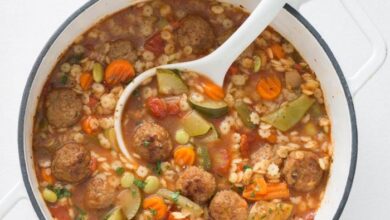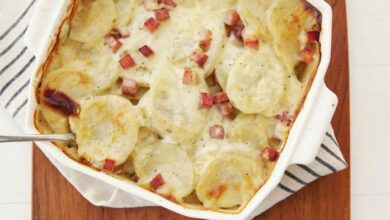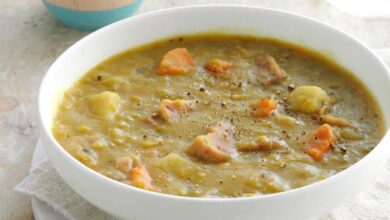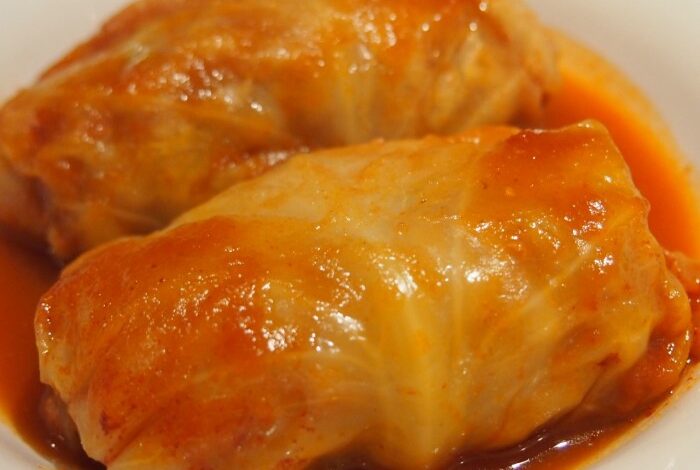
Beef and Cabbage Lazy Golumpki: A Simple Twist on a Classic
Beef and cabbage lazy golumpki is a delightful twist on the traditional Polish dish, offering a simplified approach to a comforting classic. This version eliminates the tedious process of wrapping individual cabbage rolls, creating a one-pan meal that’s perfect for busy weeknights.
While the traditional golumpki boasts a rich history and cultural significance, the “lazy” variation embraces a modern take on the beloved dish, using simple ingredients and a straightforward cooking method to achieve a delicious and satisfying meal. The combination of tender beef, flavorful cabbage, and a savory tomato sauce creates a comforting and satisfying dish that’s sure to please everyone at the table.
The key to successful lazy golumpki lies in achieving a balance of flavors and textures. The beef should be tender and juicy, while the cabbage should be cooked until it’s soft and slightly sweet. The tomato sauce should be rich and flavorful, adding a touch of acidity to complement the other ingredients.
There are endless variations of lazy golumpki, each with its own unique twist. Some recipes call for adding ground pork or sausage to the beef mixture, while others incorporate different vegetables like carrots, celery, or onions. Regardless of the specific ingredients used, the goal is to create a dish that’s both delicious and easy to make.
Beef and Cabbage Lazy Golumpki
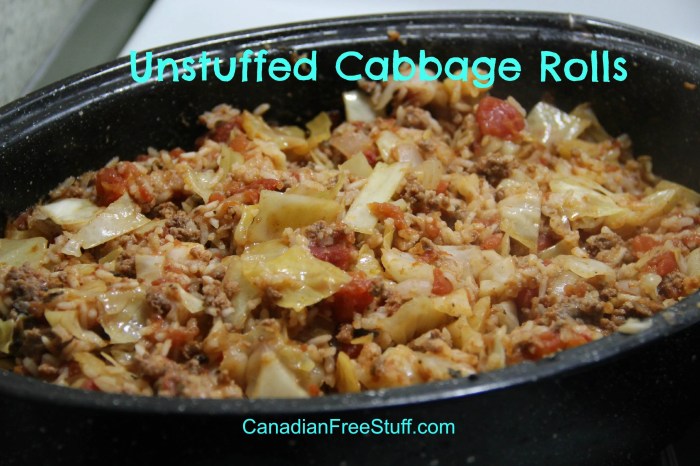
Golumpki, also known as gołąbki, are a beloved Polish dish consisting of savory cabbage rolls filled with meat and rice. These delightful parcels of flavor have a rich history, dating back centuries, and are a cherished culinary tradition in many Eastern European countries.The concept of “lazy” golumpki stems from the desire for a quicker and easier version of the classic dish.
Traditional golumpki require careful preparation, involving blanching cabbage leaves, meticulously rolling them into tight bundles, and simmering them in a flavorful broth. Lazy golumpki simplify this process by using ground meat and rice as a filling, which is then spread onto large cabbage leaves and baked in the oven.
This eliminates the need for rolling and saves time, making it a convenient and delicious option for busy weeknights.
Key Ingredients and Flavor Profile
Lazy golumpki, despite their simplified preparation, are bursting with flavor. The key ingredients include:
- Ground Beef:Provides a hearty base and a rich, savory flavor.
- Rice:Adds a fluffy texture and absorbs the flavors of the other ingredients.
- Cabbage:Offers a mild sweetness and a satisfying crunch.
- Tomato Sauce:Creates a tangy and slightly acidic sauce that complements the savory filling.
- Onions:Add a sweet and pungent aroma to the dish.
- Garlic:Provides a strong and savory flavor.
- Spices:Typically include paprika, black pepper, and bay leaves, adding depth and complexity to the dish.
The combination of these ingredients creates a balanced and satisfying flavor profile. The savory meat filling is perfectly complemented by the sweet cabbage, the tangy tomato sauce, and the aromatic spices. Lazy golumpki are a true comfort food, offering a warm and satisfying meal that is sure to please everyone at the table.
Recipe Variations and Techniques
Lazy golumpki is a versatile dish that offers numerous opportunities for customization. From altering the filling to experimenting with cooking methods, there are many ways to create a unique and flavorful version of this classic comfort food. This section explores various recipes and techniques, highlighting key variations and their impact on the final dish.
Variations in Filling
The filling of lazy golumpki is the heart of the dish, and it can be adjusted to suit different tastes and preferences.
Beef and cabbage lazy golumpki is a great weeknight meal, but sometimes you just want something warm and comforting. If you’re looking for a hearty, flavorful dish that’s perfect for a chilly evening, try my recipe for slow cooker pumpkin turkey chili.
It’s packed with flavor and is easy to make ahead, so you can enjoy a delicious meal without a lot of fuss. Once you’ve tried this chili, you’ll be ready to tackle any cold weather, even if it’s just a quick and easy beef and cabbage lazy golumpki.
- Traditional Filling:The classic filling consists of ground beef, rice, onion, and seasonings. This combination is hearty and flavorful, providing a satisfying base for the dish.
- Adding Vegetables:Incorporating chopped vegetables like carrots, celery, or mushrooms adds texture and nutritional value to the filling. These vegetables also contribute to the overall flavor profile, creating a more complex and nuanced taste.
- Using Other Meats:While ground beef is most common, other meats like ground pork, turkey, or lamb can be used. Each meat brings a unique flavor and texture to the dish, allowing for variations in taste.
- Vegetarian Option:For a vegetarian alternative, lentils, quinoa, or chopped vegetables can be used as the base of the filling. This allows for a hearty and satisfying meal that is meat-free.
Cooking Methods
Lazy golumpki can be cooked using various methods, each yielding a different texture and flavor.
- Stovetop:Cooking on the stovetop allows for a quick and easy preparation. The golumpki is simmered in a flavorful broth, resulting in a tender and juicy dish.
- Oven:Baking in the oven provides a more even cooking and allows the golumpki to develop a crispy exterior. This method also allows for the use of a variety of toppings, such as cheese or breadcrumbs.
- Slow Cooker:Using a slow cooker results in a tender and flavorful dish, as the golumpki simmers in its own juices for an extended period. This method is particularly convenient for busy weeknights.
Comparison of Cooking Methods
The choice of cooking method affects the texture and flavor of the lazy golumpki.
Beef and cabbage lazy golumpki is a comforting dish that’s perfect for a chilly evening. The tender beef and cabbage are a classic combination, and the lazy version makes it easy to prepare. To complete the meal, I love serving it with a side of roasted potatoes with greens , which adds a satisfying crunch and a touch of earthy flavor.
The combination of the hearty golumpki and the roasted vegetables is a perfect way to enjoy a simple, yet delicious, meal.
| Cooking Method | Texture | Flavor |
|---|---|---|
| Stovetop | Tender and juicy | Intense and flavorful |
| Oven | Tender with a crispy exterior | More nuanced and complex |
| Slow Cooker | Very tender and flavorful | Rich and savory |
“The choice of cooking method ultimately depends on personal preference and desired outcome.”
Serving Suggestions and Accompaniments
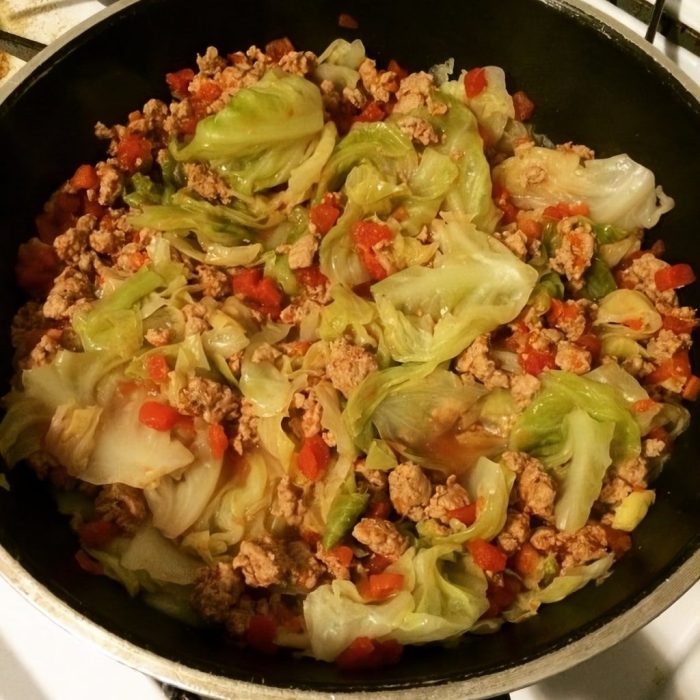
Beef and cabbage lazy golumpki, with its hearty flavors and comforting texture, is a dish that can be enjoyed in many ways. Its versatility allows for diverse serving options, from traditional accompaniments to modern twists.
Serving Suggestions
These lazy golumpki can be served as a main course, a hearty side dish, or even as a filling for sandwiches.
- Traditional Serving: Served with a dollop of sour cream or yogurt, a sprinkle of fresh dill, and a side of mashed potatoes or rice. This combination provides a comforting and satisfying meal.
- Modern Twist: For a modern take, serve the lazy golumpki with a side of quinoa or couscous, a drizzle of balsamic glaze, and a sprinkle of toasted pine nuts. This adds a touch of sophistication to the dish.
- Sandwich Filling: These lazy golumpki can also be used as a filling for sandwiches. Serve them on crusty bread with a dollop of mustard or mayonnaise, and a few slices of tomato or cucumber.
Accompaniments
The choice of accompaniments can greatly enhance the flavor and texture of the dish.
- Side Dishes: Mashed potatoes, rice, quinoa, couscous, roasted vegetables, and salads are all excellent side dishes for lazy golumpki.
- Beverages: A glass of chilled white wine, a light beer, or a refreshing iced tea pairs well with this dish.
Cultural Significance
Lazy golumpki holds cultural significance in various culinary traditions, particularly in Eastern European and Slavic cuisines.
- Eastern European Cuisine: In Eastern European cuisine, golumpki (or gołąbki) are a beloved comfort food. They are often served at family gatherings and holidays, symbolizing warmth, comfort, and tradition.
- Slavic Cuisine: In Slavic cuisine, golumpki are a popular dish, with variations in ingredients and preparation methods. They are often served with sour cream, yogurt, or a tomato-based sauce.
Sample Menu
Here is a sample menu featuring beef and cabbage lazy golumpki as the main course:
| Appetizer | Soup | Main Course | Side Dish | Dessert |
|---|---|---|---|---|
| Cucumber and Tomato Salad | Chicken Noodle Soup | Beef and Cabbage Lazy Golumpki | Mashed Potatoes | Apple Pie |
Nutritional Value and Health Considerations
Beef and cabbage lazy golumpki, a hearty and comforting dish, offers a blend of flavors and textures. Understanding its nutritional profile and potential health implications is crucial for making informed dietary choices.
Nutritional Content
This dish provides a good source of protein, essential vitamins, and minerals. The beef contributes protein, iron, zinc, and B vitamins. Cabbage is rich in vitamin C, fiber, and antioxidants. The rice adds carbohydrates for energy, while the tomato sauce provides lycopene, a powerful antioxidant.
Health Benefits
- Protein for Muscle Growth and Repair:The beef provides a substantial amount of protein, crucial for muscle growth, repair, and overall tissue maintenance.
- Fiber for Digestive Health:Cabbage is a good source of dietary fiber, promoting healthy digestion and regular bowel movements.
- Antioxidants for Cell Protection:Cabbage and tomatoes are rich in antioxidants, which help protect cells from damage caused by free radicals, potentially reducing the risk of chronic diseases.
- Iron for Oxygen Transport:The iron in beef aids in the production of red blood cells, responsible for transporting oxygen throughout the body.
Health Risks
- Saturated Fat and Cholesterol:Beef, especially fatty cuts, can be high in saturated fat and cholesterol, which may increase the risk of heart disease when consumed in excess.
- Sodium Content:The tomato sauce can be high in sodium, which may contribute to high blood pressure in individuals sensitive to salt.
- Potential for Foodborne Illness:Improper handling or cooking of meat can lead to foodborne illness. It is essential to cook beef thoroughly to kill any harmful bacteria.
Healthier Modifications
- Leaner Beef:Opt for leaner cuts of beef, such as sirloin or round, to reduce the saturated fat and cholesterol content.
- Low-Sodium Tomato Sauce:Choose low-sodium or no-salt-added tomato sauce to minimize sodium intake.
- Whole Grain Rice:Replace white rice with brown rice or quinoa for added fiber and nutrients.
- Vegetable Additions:Incorporate more vegetables, such as carrots, onions, or peppers, for additional vitamins, minerals, and fiber.
Cultural and Regional Influences
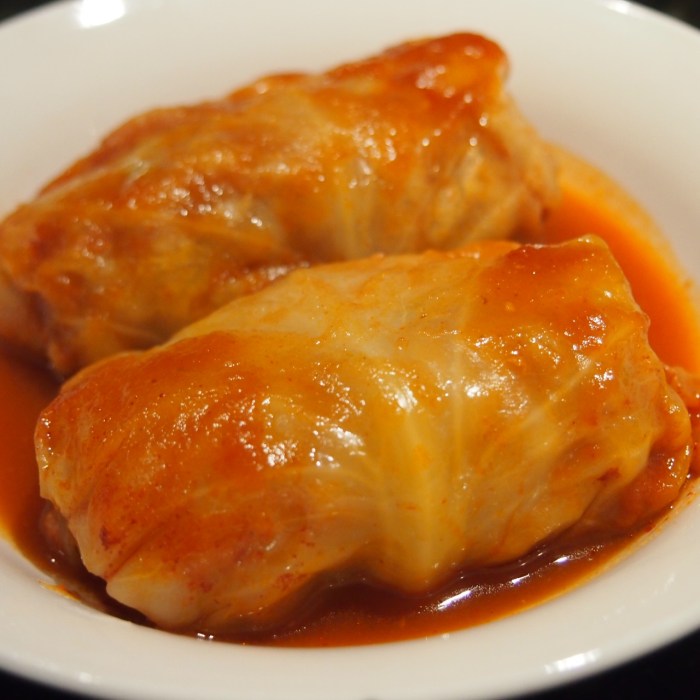
Golumpki, also known as gołąbki, are a testament to the diverse culinary traditions of Eastern Europe. The dish has evolved over centuries, adapting to local ingredients and cultural preferences, resulting in a variety of regional variations. Each region boasts unique variations in ingredients, preparation techniques, and accompanying dishes.
Beef and cabbage lazy golumpki are a comforting meal, but sometimes you crave something sweet and simple. For those days, I turn to a easy french toast casserole that’s practically foolproof. But when it’s time for hearty and satisfying, those tender cabbage leaves filled with ground beef are always a winner.
Regional Variations, Beef and cabbage lazy golumpki
The regional variations of golumpki reflect the diverse culinary landscapes of Eastern Europe. These variations showcase the unique ingredients and cultural influences that have shaped the dish over time.
- Poland: In Poland, golumpki are often filled with a mixture of ground meat, rice, and mushrooms, and served with a tomato-based sauce. Some Polish variations include adding sauerkraut or dried fruit to the filling.
- Ukraine: Ukrainian golumpki are typically filled with a mixture of ground meat, rice, and onions, and served with a rich tomato sauce. Some Ukrainian variations include adding buckwheat or barley to the filling.
- Russia: In Russia, golumpki are known as “golubtsy” and are often filled with a mixture of ground meat, rice, and vegetables, and served with a sour cream-based sauce. Some Russian variations include adding cabbage leaves to the filling.
- Belarus: Belarusian golumpki are similar to their Russian counterparts, but they are often filled with a mixture of ground meat, rice, and buckwheat, and served with a tomato-based sauce.
Historical Significance and Evolution: Beef And Cabbage Lazy Golumpki
Golumpki, also known as gołąbki in Polish, are a dish with a rich and fascinating history, reflecting the diverse cultural influences that have shaped its evolution. Its origins can be traced back to various cultures, with each contributing unique elements to the dish’s form and flavor.
Origins in Eastern Europe
The roots of golumpki can be found in Eastern European cuisine, particularly in Poland, Ukraine, and Russia. These regions have a long tradition of using cabbage leaves as a wrapper for various fillings, often incorporating meat, grains, and vegetables.
This practice dates back centuries, with evidence suggesting that similar dishes were enjoyed by Slavic peoples long before the modern golumpki emerged.
Influence of Turkish Cuisine
During the Ottoman Empire’s reign over parts of Eastern Europe, Turkish cuisine exerted a significant influence on local culinary traditions. This influence is evident in golumpki, as the dish’s use of rice as a primary ingredient is likely a result of Turkish culinary practices.
Rice, a staple in Turkish cuisine, was introduced to Eastern Europe during the Ottoman period and became a popular ingredient in many dishes, including golumpki.
Regional Variations and Evolution
Golumpki has evolved over time, adapting to local preferences and ingredients. In Poland, golumpki typically feature a filling of ground meat, rice, and onions, seasoned with spices like marjoram and paprika. Ukrainian golumpki often include a mixture of ground meat, buckwheat, and mushrooms, while Russian versions may incorporate barley or lentils.
These regional variations highlight the dish’s adaptability and its ability to incorporate local flavors and ingredients.
Cultural Significance and Family Traditions
Golumpki hold a special place in the hearts of many families in Eastern Europe, often serving as a symbol of home, comfort, and tradition. The dish is frequently prepared for special occasions, such as holidays and family gatherings, and its preparation often involves multiple generations working together.
This shared experience of preparing and enjoying golumpki strengthens family bonds and reinforces cultural traditions. The dish’s enduring popularity reflects its ability to connect people to their heritage and create lasting memories.
Evolution in the United States
Golumpki, like many other immigrant dishes, found a new home in the United States, where it was embraced by generations of Polish, Ukrainian, and Russian immigrants. In American kitchens, golumpki have undergone further evolution, incorporating local ingredients and flavors.
Some variations include the use of ground beef, tomato sauce, and American-style seasonings. These adaptations have helped to make golumpki more accessible to a wider audience, while still retaining its core elements.
Culinary Tips and Tricks
Mastering the art of lazy golumpki is all about finding the perfect balance of flavors and textures. From ingredient selection to cooking techniques, there are a few key tips and tricks that can elevate your dish to new heights.
Ingredient Selection
The quality of your ingredients directly impacts the final taste of your lazy golumpki.
- Beef:Opt for lean ground beef, such as 80/20 or 90/10, for a flavorful and juicy filling. Avoid using ground beef that is too fatty, as it can make the filling greasy.
- Cabbage:Choose firm, dense heads of cabbage with tightly packed leaves. Avoid cabbage that is soft, wilted, or has any blemishes.
- Rice:Long-grain white rice is the preferred choice for lazy golumpki, as it holds its shape well and absorbs the flavors of the filling. Avoid using instant rice, as it tends to become mushy when cooked.
- Tomato Products:Use high-quality canned diced tomatoes or crushed tomatoes for a richer flavor. Avoid using tomato sauce, as it can make the filling too acidic.
Cooking Techniques
- Sautéing the Filling:Properly sautéing the filling before adding it to the cabbage leaves is crucial for developing a deeper flavor. Be sure to cook the ground beef until browned and the onions are softened.
- Blanching the Cabbage Leaves:Blanching the cabbage leaves in boiling water for a few minutes makes them more pliable and easier to work with. It also helps to reduce the bitterness of the cabbage.
- Simmering the Golumpki:Simmer the lazy golumpki in a flavorful broth or tomato sauce for at least 30 minutes, allowing the flavors to meld and the filling to cook through.
Flavor Enhancement
- Seasoning:Don’t be afraid to experiment with different seasonings to enhance the flavor of your lazy golumpki. Common additions include salt, pepper, paprika, garlic powder, onion powder, and cumin.
- Fresh Herbs:Adding fresh herbs, such as parsley, dill, or chives, can add a bright and aromatic dimension to the dish.
- Sour Cream or Yogurt:A dollop of sour cream or yogurt on top of the finished lazy golumpki provides a tangy and creamy contrast to the savory filling.
Common Mistakes to Avoid
- Overfilling the Cabbage Leaves:Don’t overfill the cabbage leaves, as they will be difficult to roll and may burst during cooking.
- Undercooking the Filling:Ensure the ground beef is cooked through before adding it to the cabbage leaves.
- Overcooking the Cabbage Leaves:Overcooked cabbage leaves will become mushy and lose their texture.

